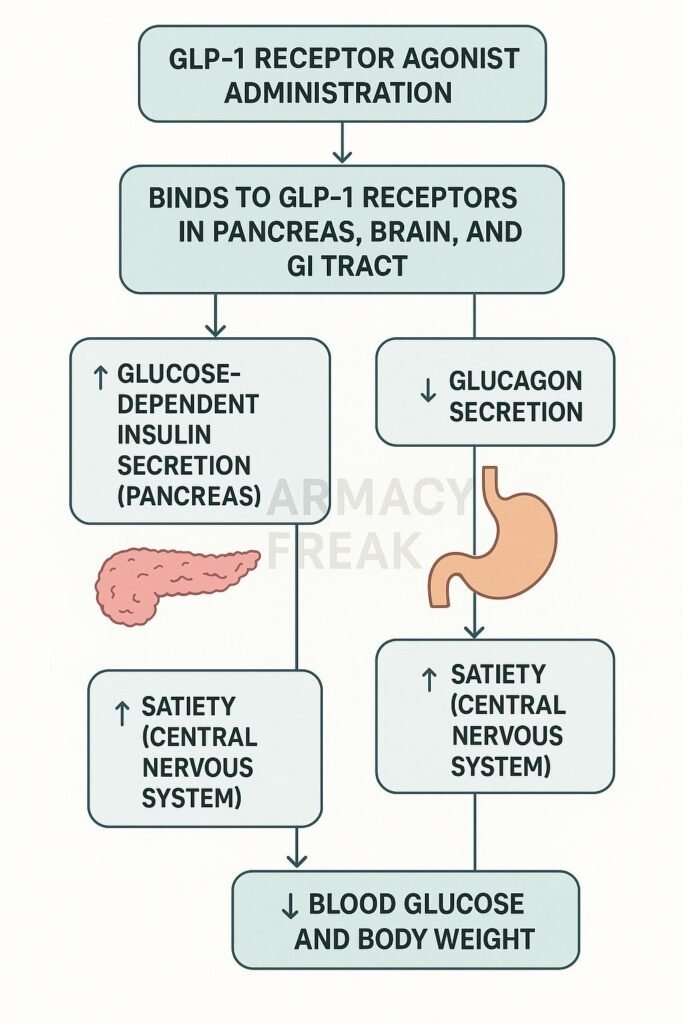Table of Contents
Introduction
GLP-1 receptor agonists are a class of antidiabetic drugs that mimic the action of glucagon-like peptide-1 (GLP-1), an incretin hormone that enhances insulin secretion in response to meals. These agents are used primarily in the treatment of type 2 diabetes mellitus and obesity. Their unique ability to improve glycemic control without causing significant hypoglycemia, along with favorable effects on weight and cardiovascular risk, makes them highly valuable in metabolic therapy.
Step-by-Step Mechanism of Action
- GLP-1 Receptor Activation
GLP-1 receptor agonists bind to and activate the GLP-1 receptors, which are G-protein-coupled receptors located in pancreatic beta cells, the brain, gastrointestinal tract, and heart. - Glucose-Dependent Insulin Secretion
Activation of GLP-1 receptors enhances insulin secretion in a glucose-dependent manner, helping lower postprandial glucose levels without causing hypoglycemia. - Suppression of Glucagon Secretion
These agents reduce glucagon secretion from pancreatic alpha cells, particularly during hyperglycemia, which helps decrease hepatic glucose output. - Delayed Gastric Emptying
GLP-1 receptor agonists slow gastric emptying, leading to reduced postprandial glucose spikes and increased satiety. - Appetite Suppression
They act on the hypothalamus to reduce appetite and promote weight loss, an important benefit in patients with obesity and type 2 diabetes. - Cardiovascular and Renal Effects
Some GLP-1 receptor agonists have shown cardiovascular benefits, including reduced risk of major adverse cardiac events. They also exert nephroprotective effects by reducing albuminuria and oxidative stress.

Pharmacokinetic Parameters
| Parameter | Value (Varies by Agent) |
|---|---|
| Route | Subcutaneous (most), oral (semaglutide) |
| Bioavailability | Low (oral semaglutide ~1%) |
| Tmax | 1–4 hours (short-acting); ~24–48 h (long-acting) |
| Half-life | 2–4 h (exenatide); ~5–7 days (semaglutide) |
| Metabolism | Proteolytic degradation |
| Excretion | Renal (peptide degradation products) |
Clinical Uses
- Type 2 diabetes mellitus
- Obesity management
- Cardiovascular risk reduction in patients with diabetes
- Nonalcoholic fatty liver disease (off-label, investigational)
Adverse Effects
- Nausea and vomiting
- Diarrhea
- Pancreatitis (rare)
- Thyroid C-cell tumors (rodent studies)
- Injection site reactions (if injectable)
Comparative Analysis
| Drug | Dosing Frequency | Weight Loss Benefit | CV Benefit | Notable Notes |
|---|---|---|---|---|
| Exenatide | Twice daily | Moderate | No | Short-acting |
| Liraglutide | Once daily | High | Yes | FDA-approved for weight loss |
| Semaglutide | Once weekly/oral | Very high | Yes | Oral and injectable forms |
| Dulaglutide | Once weekly | High | Yes | Easy weekly dosing |
MCQs
- GLP-1 receptor agonists primarily act on:
a) Alpha cells b) Beta cells c) Delta cells d) Hepatocytes
Answer: b) Beta cells - These drugs increase insulin secretion in a:
a) Continuous manner b) Glucose-independent way c) Glucose-dependent way d) Inhibited state
Answer: c) Glucose-dependent way - Which of the following is a known adverse effect of GLP-1 agonists?
a) Hypoglycemia b) Bradycardia c) Nausea d) Tachycardia
Answer: c) Nausea - GLP-1 agonists help reduce weight by:
a) Increasing insulin resistance b) Enhancing appetite c) Suppressing appetite d) Stimulating glucagon
Answer: c) Suppressing appetite - Which agent is available in oral formulation?
a) Exenatide b) Liraglutide c) Dulaglutide d) Semaglutide
Answer: d) Semaglutide - Cardiovascular benefits of GLP-1 agonists are most evident in:
a) Type 1 diabetes b) Type 2 diabetes with CV risk c) Healthy adults d) Children
Answer: b) Type 2 diabetes with CV risk - GLP-1 receptor agonists delay:
a) Insulin action b) Glucose absorption c) Gastric emptying d) Renal excretion
Answer: c) Gastric emptying - Pancreatitis is a:
a) Common effect b) Contraindication c) Rare adverse effect d) Desired action
Answer: c) Rare adverse effect - Main site of GLP-1 receptor action for appetite regulation is:
a) Pancreas b) Liver c) Hypothalamus d) Kidney
Answer: c) Hypothalamus - Liraglutide is FDA-approved for:
a) Anemia b) Depression c) Weight loss d) Osteoporosis
Answer: c) Weight loss
FAQs
1. Can GLP-1 receptor agonists be used in type 1 diabetes?
Not recommended, as they rely on functional beta cells to exert their glucose-lowering effect.
2. How long does it take to see results?
Glycemic improvement is often seen within weeks; weight loss benefits take a few months.
3. Are these drugs used alone or with others?
They can be used as monotherapy or in combination with metformin, SGLT2 inhibitors, or insulin.
4. Is there a risk of hypoglycemia?
Low, unless combined with insulin or sulfonylureas.
5. Do these drugs protect the heart?
Yes, certain agents like liraglutide and semaglutide have shown cardiovascular benefits.
References
- PubMed: GLP-1 receptor agonists mechanism
- DrugBank: GLP-1 agonist pharmacology
- StatPearls: Incretin-based therapies
- FDA: Liraglutide and Semaglutide labels
- Diabetes Care: Clinical trials on GLP-1 agonists
Related Links
Mechanism of Action of Amantadine
MCQ Quiz: Management of Parkinson’s Disease

I am pursuing MBA in pharmaceutical management from NIPER Hyderabad with a strong academic record and proven success in national-level pharmacy entrance exams. I secured AIR 61 in NIPER 2024 (MS/M.Pharm) and AIR 27 in NIPER MBA, along with AIR 147 in GPAT 2024 and AIR 907 in GPAT 2023. I also achieved AIR 6 in AIIMS CRE-2025 for Drug Store Keeper and was selected as a Pharmacist (AIR 61) for ESIC. Additionally, I was the Runner-Up in Round 2 of the EY Case Study Competition.
At PharmacyFreak.com, I aim to guide future pharmacists through expert content, exam strategies, and insightful resources based on real experience and academic excellence.
Mail- harsh@pharmacyfreak.com
